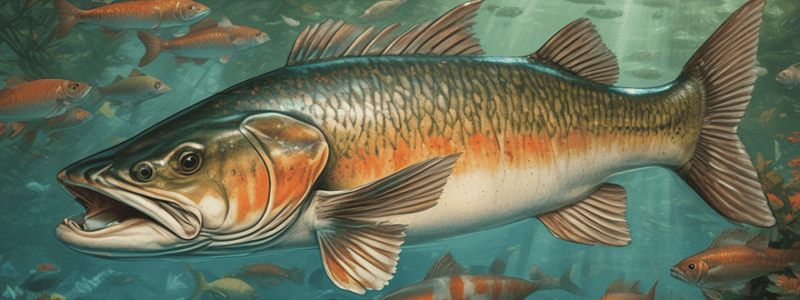Podcast
Questions and Answers
What is a characteristic of type II survivorship curves?
What is a characteristic of type II survivorship curves?
- Mortality is equally likely to occur at any point in the lifespan (correct)
- Mortality is highest in early ages
- Survival rates increase with age
- Organisms produce large numbers of offspring
Which organism is most likely to exhibit a type III survivorship curve?
Which organism is most likely to exhibit a type III survivorship curve?
- Humans
- Marine invertebrates (correct)
- Birds
- Mammals
Why do trees exhibit a type III survivorship curve?
Why do trees exhibit a type III survivorship curve?
- They have high mortality in advanced age
- Most do not survive their younger years (correct)
- They have a high survival rate in early years
- They provide extensive care to their offspring
Which population shows a Type I survivorship curve?
Which population shows a Type I survivorship curve?
What happens to the survival rates as age increases in type II survivorship curves?
What happens to the survival rates as age increases in type II survivorship curves?
Which of the following fish is considered an invasive species that threatens native species in the United States?
Which of the following fish is considered an invasive species that threatens native species in the United States?
What is the study of populations called?
What is the study of populations called?
Which of the following factors can influence the size and composition of populations?
Which of the following factors can influence the size and composition of populations?
What is the main purpose of studying populations according to the text?
What is the main purpose of studying populations according to the text?
Which of the following is NOT mentioned as an example of an invasive species in the text?
Which of the following is NOT mentioned as an example of an invasive species in the text?
What type of distribution pattern do territorial birds such as penguins tend to have?
What type of distribution pattern do territorial birds such as penguins tend to have?
In the context of territorial animal species, what does a clumped distribution pattern signify?
In the context of territorial animal species, what does a clumped distribution pattern signify?
What type of distribution pattern is exhibited by plants like dandelions with wind-dispersed seeds?
What type of distribution pattern is exhibited by plants like dandelions with wind-dispersed seeds?
What does a type I survivorship curve indicate?
What does a type I survivorship curve indicate?
What do species with a clumped distribution pattern like elephants tend to do?
What do species with a clumped distribution pattern like elephants tend to do?
Which of the following factors characterizes a population?
Which of the following factors characterizes a population?
What is the relationship between population density and body size in organisms?
What is the relationship between population density and body size in organisms?
Which method is commonly used to estimate population size for immobile or small, slow-moving organisms?
Which method is commonly used to estimate population size for immobile or small, slow-moving organisms?
What is the assumption behind the mark and recapture method for estimating population size?
What is the assumption behind the mark and recapture method for estimating population size?
Which distribution pattern is observed in plants that secrete substances inhibiting the growth of nearby individuals?
Which distribution pattern is observed in plants that secrete substances inhibiting the growth of nearby individuals?
What is the significance of studying species distribution patterns?
What is the significance of studying species distribution patterns?
Which distribution pattern is observed in plants that have wind-dispersed seeds?
Which distribution pattern is observed in plants that have wind-dispersed seeds?
What is the purpose of sampling a representative portion of a habitat to study a population?
What is the purpose of sampling a representative portion of a habitat to study a population?
Which distribution pattern is observed in animals that live in social groups?
Which distribution pattern is observed in animals that live in social groups?
What is the significance of population size in terms of adaptation?
What is the significance of population size in terms of adaptation?
Match the survivorship curve type with its corresponding description:
Match the survivorship curve type with its corresponding description:
Match the organism with its corresponding survivorship curve type:
Match the organism with its corresponding survivorship curve type:
Match the survivorship curve pattern with its corresponding example in nature:
Match the survivorship curve pattern with its corresponding example in nature:
Match the distribution pattern with the corresponding type of species:
Match the distribution pattern with the corresponding type of species:
Flashcards are hidden until you start studying




